Henry Sugimoto Collection
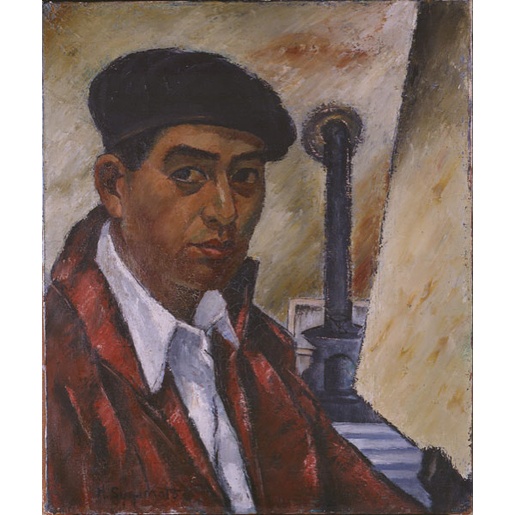
|
||
| Licensing | ||
Henry Sugimoto was born in 1900 in Wakayama, Japan, and lived until the year 1990. During his lifetime, he created hundreds of works of original art, many pieces depicting the everyday lives of Japanese Americans in the World War II concentration camps, the experiences of Japanese American soldiers, and the Issei experience.
This collection displays some of his most inspirational and meaningful pieces. It begins with a few of his pre-war works, and finishes with his post-war pieces. To see his other work, please visit the Japanese American National Museum website.
Here, you can also find collections of other important and influential people like Clara Breed and Hideo Date. Sugimoto displays his life experiences through his works of art. So, learn through his art, live through his art. Enjoy the story!
Copyright for the paintings is held by the Japanese American National Museum. Short-term educational use with limited circulation is permitted. For all other uses, please contact the Hirasaki National Resource Center at the Japanese American National Museum (hnrc@janm.org).
Slides in this album |
|

|
Henry Sugimoto, "Self-Portrait"This self-portrait was created during Sugimoto's time in France, before World War II, during his formative years as an artist. The blank canvas in front of him may very well represent the endless possibilities that were before him, his own personal blank canvas. Sugimoto is often shown in his beret, … |
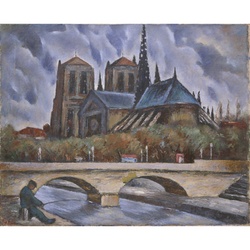
|
Henry Sugimoto, "Notre Dame Cathedral"After attending art school in the United States, Sugimoto traveled to France, where he hoped to learn more about art, and be inspired to create masterpieces. He did indeed mature artistically, and this painting is one of many that are proof of his success. One should notice that Sugimoto's early … |

|
Henry Sugimoto, "Yosemite River"Sugimoto enjoyed painting pictures of his environment, and was inspired by nature. His trip to Yosemite yielded many great pieces. This is just one of Sugimoto's many Yosemite paintings. |

|
Henry Sugimoto, "Going to America"This piece was created long after World War II ended. It depicts the journey that the Issei took in immigrating from Japan to the United States. It was very likely inspired by Sugimoto's own travels and experiences. |
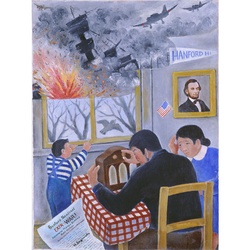
|
Henry Sugimoto, "Untitled (News of Pearl Harbor)"December 7, 1941 changed the lives of thousands of Japanese Americans. It is a day that will always be remembered. This piece represents the feelings, emotions and reactions of Japanese Americans to the news of the bombing. It serves as a reminder of the day that will never be forgotten. …
Henry Sugimoto, "Untitled (News of Pearl Harbor)" |
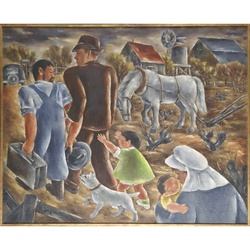
|
Henry Sugimoto, "My Papa"After the bombing of Pearl Harbor, the United States government viewed Japanese Americans as threats to the country, especially Japanese-language schoolteachers and those in possession of anything relating to Japan, such as a picture of the Japanese emperor. This piece shows a Japanese American father being taken away from his … |
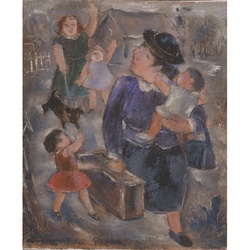
|
Henry Sugimoto, "Goodbye Mary"This painting shows a Japanese American woman, presumably Mary, waving goodbye to a woman who seems to be her neighbor, as she and her children are relocated. This picture represents the lives and friendships that the Issei and Nisei had before they were rushed off to the camps. Sugimoto painted … |
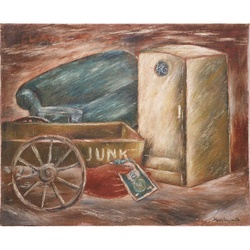
|
Henry Sugimoto, "One Dollar for Nice Icebox, When the [he] Came Out (One Dollar for Nice Icebox, When War Broke Out)"Because the Japanese Americans were forced out of their homes in such a rushed manner, they had no other choice but to sell their belongings. Sugimoto's paintings show the way in which the surrounding community took advantage of this. People bought the Japanese Americans' belongings for almost nothing, which is …
Henry Sugimoto, "One Dollar for Nice Icebox, When the [he] Came Out (One Dollar for Nice Icebox, When War Broke Out)" |
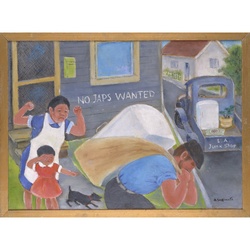
|
Henry Sugimoto, "Documentary, Junk Shop Man Took Away Our Ice Box"As mentioned in the previous slide, Japanese Americans were forced to get rid of any possessions which they could not carry with them to the camps. This meant that they had to sell their furniture, kitchen appliances, and other simliar larger items. This painting shows how some people really took …
Henry Sugimoto, "Documentary, Junk Shop Man Took Away Our Ice Box" |
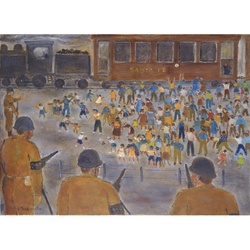
|
Take fresh air ? (Fresh air break on the trip from Fresno to Jerome)To get to the camp in Jerome, Arkansas, Sugimoto and his family had to travel a very long distance in a very old train. They were given periodic "breaks" to stretch and breathe in fresh air. During these breaks, as you can see in the picture, there were guards observing …
Henry Sugimoto, "Take fresh air ? (Fresh air break on the trip from Fresno to Jerome)" |
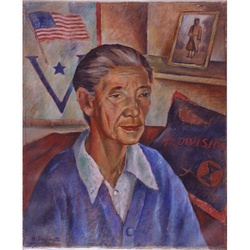
|
Henry Sugimoto, "Mother in Jerome Camp"Sugimoto paints his mother while at camp. Although she looks quite old, she is only in her 60's. This is a result of camp life, and Sugimoto showed the consequences of the poor living conditions at the camp at Jerome. Behind the woman is an American flag, a large … |

|
Henry Sugimoto, "Praying for Safety"This piece serves as a reflection of Sugimoto's deep faith. Two elderly Japanese Americans, probably Issei, pray for their friends and family, for their children and for each other. Sugimoto, in a draft of his redress testimony given in 1981, said, "Would you join me in a silent prayer for … |

|
Henry Sugimoto, "Bye Bye Daddy"Once they were settled into the camps, many families were torn apart by the need for Japanese American soldiers to serve in the war. This painting shows one soldier leaving his family behind to go to fight in the war, a scene that Sugimoto would have been very familiar with. … |
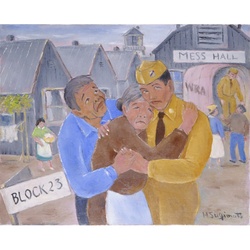
|
Henry Sugimoto, "Goodbye My Son"In addition to fathers leaving their wives and children, they also left their mothers and fathers to go to war. This painting shows the pain and reluctance felt by parents when their sons had to leave the family to fight. This is also a scene that Sugimoto would have often … |

|
Henry Sugimoto, "Senninbari (Thousand Stitches)"It was customary for Issei mothers of soldiers to fashion a "senninbari," or a talisman made of cloth. This protective garment would have had a picture in the middle, with one thousand stitches sewn by women of the camp. This painting shows Sugimoto's sympathy for the Issei mothers who had …
Henry Sugimoto, "Senninbari (Thousand Stitches)" |
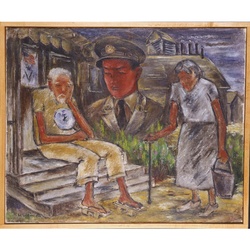
|
Henry Sugimoto, "Old Parents Thinking About Their Son on the Battlefield"This photo shows two Issei parents thinking about thier son at war. This scene would have applied to many families and elderly couples in the camps, and Sugimoto may have seen this quite often, for many young men were called to, or volunteered to fight in, the war. It is …
Henry Sugimoto, "Old Parents Thinking About Their Son on the Battlefield" |
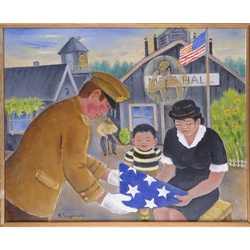
|
Henry Sugimoto, "Died in Battlefield"Unfortunately, because many young men went off to war, some of them failed to return, leaving their families with little more than memories of their sons, fathers, brothers and husbands. Sugimoto sought to capture this tragedy in the camps, to capture the camp experience for the world to see. |

|
Henry Sugimoto, "Documentary-Nisei Soldiers Returning the Flag of 442nd to the President"This painting shows the 442nd Regiment returning their flag to President Harry S. Truman. With the nation's capitol visible in the background, it is clear that Sugimoto intended to show the patriotism of the soldiers of the 442nd, and the fact that they fought whole-heartedly for the United States of …
Henry Sugimoto, "Documentary-Nisei Soldiers Returning the Flag of 442nd to the President" |
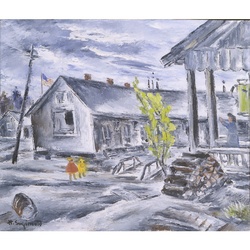
|
Henry Sugimoto, "Untitled"The exact camp is not specified in the title, but this is probably a representation of the concentration camp at Jerome. The white and grey tones suggest a barren, cold and unwelcoming place. However, the two children and the women waving to them suggest that although the conditions were difficult … |

|
Henry Sugimoto, "Untitled (Arkansas Camp B)"This painting reminds one of Sugimoto's earlier works, which focused primarily on the landscape, with people having little detail. The prominent man in this painting, however, does have a bit of detail. His orientation is clear, as is the items he carries. It seems like Sugimoto wanted to represent what … |
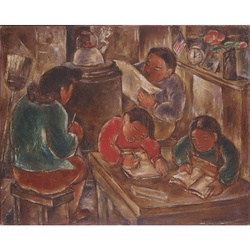
|
Henry Sugimoto, "Family in Camp Room"Here, Sugimoto tries his best to show us how the living conditions were in the concentration camp barracks. The barracks were often very small, and sometimes occupied by more than one family. There was no privacy, as is evident by the painting. The mother sews and the father reads the … |

|
Henry Sugimoto, "Documentary, Going to Shower in Fresno Assembly Camp"This painting, too, shows the living conditions of the camp at Jerome, and is really representative of all of the concentration camps across the nation. The woman and child here represent Sugimoto's wife, Susie, and his daughter, Madeleine, who had to walk in their robes to a central facility to …
Henry Sugimoto, "Documentary, Going to Shower in Fresno Assembly Camp" |
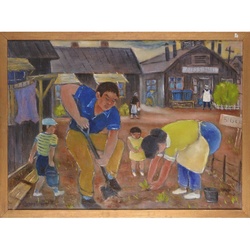
|
Henry Sugimoto, "Planting Vegetables"Sugimoto depicts here a family tending to their garden, which was a common pastime in the concentration camps. As is clearly shown, the entire family tended to their humble garden together. We must not forget the others in this painting, though. The various figures in the background represent the various … |
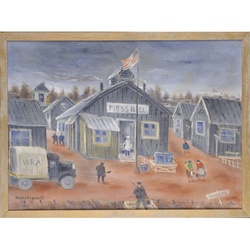
|
Henry Sugimoto, "Mess hall Jerome Camp (Our mess hall (documentary))"This painting of the Mess Hall in Jerome centers on the mess hall itself. The hall was an important building, where all of the internees obtained food and nutrition, both necessary for survival. I would encourage one to also observe the guard tower in the distance, the WRA truck, and …
Henry Sugimoto, "Mess hall Jerome Camp (Our mess hall (documentary))" |

|
Henry Sugimoto, "Documentary, Our Mess Hall"This painting shows the inside of the Mess Hall previously shown. Here, Sugimoto pays attention to the detail of the people as he paints. Hints of emotion can be detected, like in the child in green who refuses to eat what his mother offers. Because the Japanese Americans were only … |

|
Henry Sugimoto, "Documentary, Our Washroom, Jerome Camp"Just like the central eating facilities and the central shower rooms, the camp at Jerome had central washrooms as well. As seen in the painting, the sinks were grouped into four, and bathing, dishwashing, and laundry was all done there.
Henry Sugimoto, "Documentary, Our Washroom, Jerome Camp" |

|
Henry Sugimoto, "Susie Ironing Camp Room"This painting shows the activities of a typical woman at the camps, and also shows Sugimoto's increased ability to make people the focal point of his paintings. This is representative of Sugimoto's maturation as an artist. |
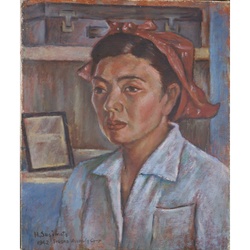
|
Henry Sugimoto, "Susie in Camp Jerome"This work is unique, becase instead of showing Susie and Madeleine as two general figures together, as Sugimoto did in past paintings, he keeps the focus on only Susie, and does an excellent job in capturing her emotions and her experiences. |
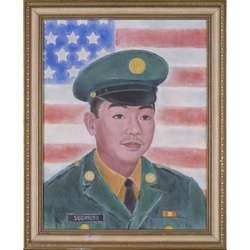
|
Henry Sugimoto, "Phillip? (Phillip-PVT. U.S. Army)"Phillip, the young man in this painting, was Sugimoto's son, who served in the United States Army.
Henry Sugimoto, "Phillip? (Phillip-PVT. U.S. Army)" |
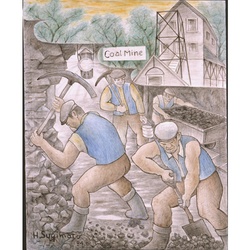
|
Henry Sugimoto, "Untitled (Coal Miners)"Many years after the war, Sugimoto went back and created works to honor the Issei. This painting, and those that follow, show the activities and the experiences of the Issei before the bombing of Pearl Harbor. |
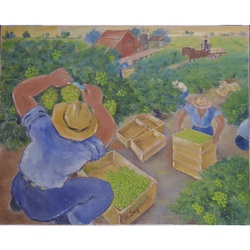
|
Henry Sugimoto, "Picking Grapes"Picking grapes was one activity that the Issei took part in the United States before being sent to the camps. This painting is part of Sugimoto's tribute to the Issei and the Issei experience. |
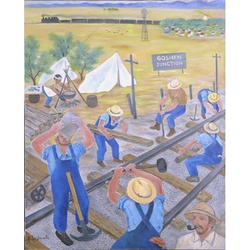
|
Henry Sugimoto, "Railroad Work"Working on the railroads was another activity of the Issei before the bombing of Pearl Harbor. The location in this painting is near Hanford, where Sugimoto and his parents lived before he left for France. It is probable that Sugimoto was personally familiar with this place. |
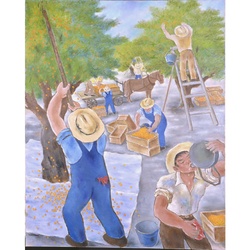
|
Henry Sugimoto, "Working on Farm"This painting is part of Sugimoto's Japanese Immigration History Series. It shows Issei farmers on an apricot farm, some picking, some transporting, all working diligently. Like most of Sugimoto's other works about Issei, this painting was completed many years after the war. |
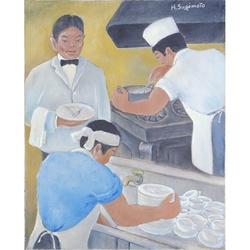
|
Henry Sugimoto, "Washing Dishes"This painting was done many years after the war was over, and depicts the lives and activities of the Issei before the bombing of Pearl Harbor. |

|
Henry Sugimoto, "Untitled"This painting depicts a Japanese-language schoolteacher in California teaching his students katakana. Shortly after the bombing of Pearl Harbor, the United States FBI sought out any Japanese American that they considered a threat to the U.S. One of the "threatening" occupations was the Japanese-language schoolteacher, and many of them were … |
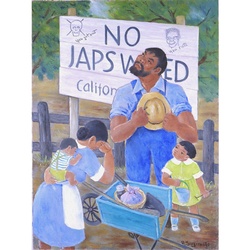
|
Henry Sugimoto, "Untitled ('No Japs Wanted')"This painting shows the discrimination and prejudice endured by the Japanese Americans. With the detail in the face of the family members, Sugimoto captures the emotions of this ostracized Japanese American family. |

|
Henry Sugimoto, "Untitled (Stop Picture Bride)"Japanese men immigrated to the United States first, mostly to work and earn a sufficient amount of money, with the hopes of returning home. However, once in the U.S., many decided to remain. In order to begin a family, the men mailed their parents pictures of themselves, and the parents …
Henry Sugimoto, "Untitled (Stop Picture Bride)" |

|
Henry Sugimoto, "Untitled"This is a portrait of four prominent Issei pioneers, Yaemon Minami, Keisaburo Koda, George Shima and Kyutaro Abiko. This was part of Sugimoto's later paintings in honor of the Issei. |
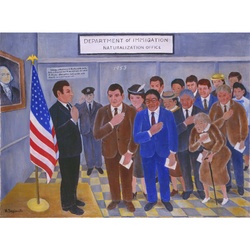
|
Henry Sugimoto, "Untitled"This is the Sugimoto's Naturalization ceremony, which took place in 1953. Sugimoto stands in the blue suit in the front row, facing the viewer. This is a deserving conclusion to Sugimoto's experiences and struggles. |
Part of these albums

|
Japanese American History from Early Immigration to Present Time nicolemyoung
nicolemyoung
|

|
 UCLA Nikkei Student Union Culture Night 2008
UCLA Nikkei Student Union Culture Night 2008 The Sculpture of Ruth Asawa: Contours in the Air - Audio Tour
The Sculpture of Ruth Asawa: Contours in the Air - Audio Tour Wakatay Restaurant-Peruvian Nikkei Cuisine
Wakatay Restaurant-Peruvian Nikkei Cuisine 2007 Gardena Buddhist Church Obon
2007 Gardena Buddhist Church Obon Frank Kikuchi
Frank Kikuchi Hisako Hibi
Hisako Hibi San Jose Taiko and CAVA - 1st and Central Summer Concerts 2007
San Jose Taiko and CAVA - 1st and Central Summer Concerts 2007 2007 Higashi Honganji Buddhist Temple Obon
2007 Higashi Honganji Buddhist Temple Obon Landscaping America: Beyond the Japanese Garden - Timeline
Landscaping America: Beyond the Japanese Garden - Timeline Jack Iwata Collection
Jack Iwata Collection
 Journal feed
Journal feed
